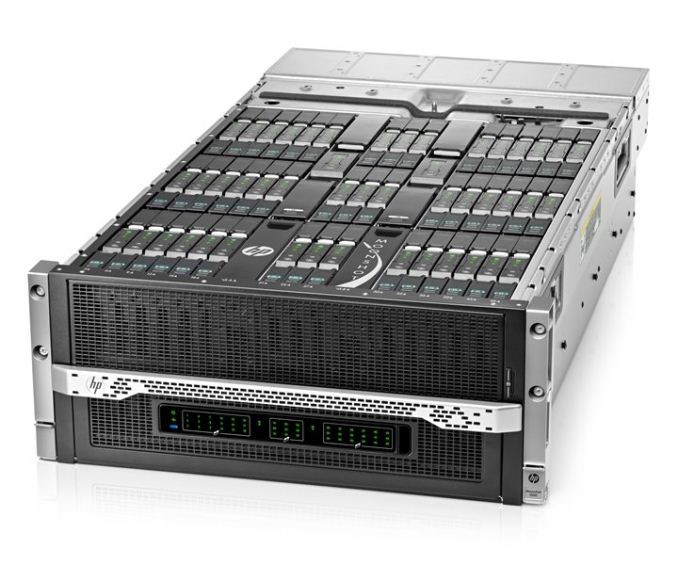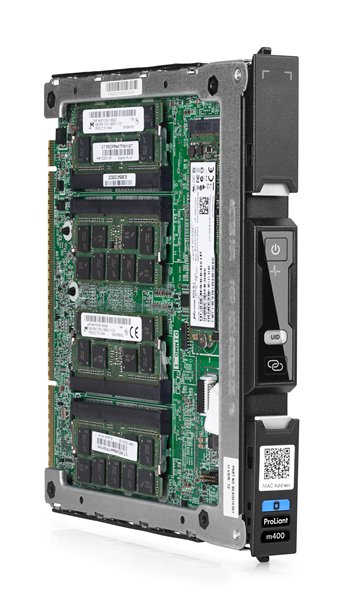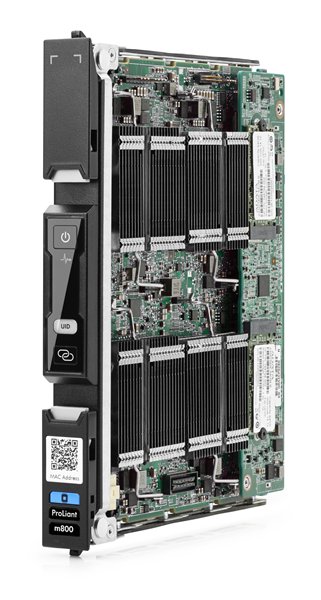HP, AppliedMicro and TI Bring New ARM Servers to Retail
by Stephen Barrett on September 30, 2014 9:19 AM EST- Posted in
- IT Computing
- HP
- Arm
- TI
- AppliedMicro
- SoCs
- server
- ARMv8

Yesterday HP announced retail availability of two ARM based servers, the ProLiant m400 and m800. Each are offered in a server cartridge as part of the Moonshot System. A single 4.3U Moonshot chassis can hold 45 server cartridges. Usually higher numbers mean better, but in this case the m400 and m800 are so significantly different I wouldn’t consider them competitors. The m800 is focused on parallel compute and DSP, while the m400 is focused on compute, memory bandwidth, IO bandwidth and features the first 64-bit ARM processor to reach retail server availability.
| HP ProLiant ARM Servers | |||||||||||
| m400 | m800 | ||||||||||
| Processors | 1 | 4 | |||||||||
| Processor |
AppliedMicro X-Gene Custom 64-bit ARMv8 |
TI KeyStone II 66AK2H Cortex-A15 ARMv7A + DSP |
|||||||||
| Compute cores per processor |
8 CPU |
4 CPU 8 DSP |
|||||||||
| Clock Speed | 2.4 GHz | 1.0 GHz | |||||||||
| Cache Memory |
Each core: 32KB L1 D$ and I$ Each pair: 256KB L2 All cores: 8MB L3 |
Each DSP core: 1MB L2 | |||||||||
| Memory |
Quad Channel 8 SODIMM Slots DDR3-1600 Low Voltage Max: 64GB (8x8GB) |
Single Channel 4 SODIMM Slots DDR3-1600 Low Voltage Max: 32GB (4x8GB) |
|||||||||
| Network Controller | Dual 10GbE | Dual 1GbE | |||||||||
| Storage | M.2 2280 | M.2 2242 | |||||||||
| PCIe | 3.0 | 2.0 | |||||||||
Starting with the m400, HP designed in a single AppliedMicro X-Gene SoC at 2.4 GHz. AppliedMicro has been discussing the X-Gene processor for several years now, and with this announcement becomes the first vendor to achieve retail availability of a 64-bit ARMv8 SoC other than Apple. Considering Apple doesn’t sell their processors stand-alone, this is a significant milestone. AppliedMicro has significantly beaten AMD’s A1100 processor to market, as AMD has not yet entered production. Marquee features of the X-Gene SoC include 8 custom 64-bit ARM cores, which at quad-issue should be higher performance than A57, quad channel DDR3 memory, and integrated PCIe 3.0 and dual 10GbE interfaces. Look out for a deep dive on the X-Gene SoC in a future article.
The m800 is a 32-bit ARM server containing four Texas Instruments KeyStone II 66AK2H SoCs at 1.0 GHz. Each KeyStone II SoC contains four A15 CPU cores alongside eight TI C66x DSP cores and single channel DDR3 memory, for a total of 16 CPU and 32 DSP cores. IO steps back to dual GbE and PCIe 2.0 interfaces. It is clear from the differences in these servers that m400 and m800 target different markets. There isn’t yet a best-of-both-worlds server combining the core count and memory + IO interfaces of the m400 and m800 together.
Each server is available with Ubuntu and IBM Informix database preinstalled, and will be demonstrated at ARM TechCon October 1-3 in Santa Clara, California.
Source: HP












33 Comments
View All Comments
Kevin G - Tuesday, September 30, 2014 - link
Good to hear about the coming deep dive into the X-Gene. I'm really curious how it compares to Apple's A7 and A8 (granted they are targeted at radically different markets).Interesting. I thought that TI had gotten out of the SoC business. Perhaps that was only in the ultra mobile front?
The m800 is interesting due to the DSPs. It should also be noted that while there are four chips on the cartridge, they are not in a SMP topology. Rather this cartridge should logically be seen as four nodes. Max memory per node is 8 GB which allows one 32 bit application a full 4 GB with a PAE-like extension enabling the rest for other applications.
DanNeely - Tuesday, September 30, 2014 - link
They only left the smartphone/tablet market They're still in all the other embedded markets they've always supported.Lord of the Bored - Friday, December 19, 2014 - link
And now they're back in the high-end business computer space, which they left decades ago!If only HP had designated that model the m990... what a wasted opportunity. :(
hamiltenor - Tuesday, September 30, 2014 - link
For reference, here is TI's marketing stuff on their website for the A15 CPUshttp://www.ti.com/lsds/ti/arm/keystone/arm_cortex_...
Wolfpup - Tuesday, September 30, 2014 - link
Are these things actually competitive with x86? I mean obviously when you have something that doesn't scale well they can't be, but are they even for things that do? It doesn't really seem like ARM's that competitive even on the low end when it comes to things like tablets...Flunk - Tuesday, September 30, 2014 - link
It mostly depends on how much the ARM server will cost all together, along with power efficiency. It doesn't have to be as powerful as an Intel system the same size if for example it's half the price and uses half the energy. There are really too many variables to tell until they do a full test.A lot of server loads are very parallel so that probably isn't a concern.
andrewaggb - Tuesday, September 30, 2014 - link
I suspect the cores are nowhere near the speed of a xeon. But it should have decent I/O performance. I'm sure the DSP version will be very fast at a few things. Not sure if they announced what those things are yet :-)patrickjchase - Wednesday, October 1, 2014 - link
The DSP in these is the TI C66, which is actually an 8-wide VLIW CPU rather than a classic DSP. I've programmed them before and they're fast across a fairly wide range of applications, though they do require a much higher level of programmer skill than most CPUs.MrSpadge - Tuesday, September 30, 2014 - link
Don't discount them yet. ARM V8 can offer nice performance boosts, as Anand has shown using Apple hardware. And with 4-wide cores the X-Gene is more beefy than your typical smartphone / tablet CPUs. I hope they're giving it 4 memory channels for good reason (other than a crappy memory controller..)!iwod - Tuesday, September 30, 2014 - link
Intel still wins I/O and Network. Atom CPU will beat this pref wise. So the problem really is price and market fit.